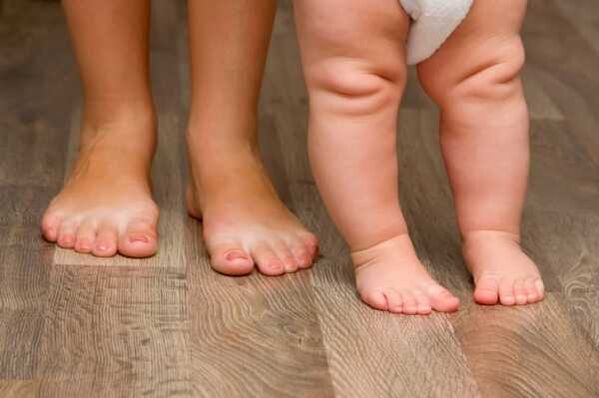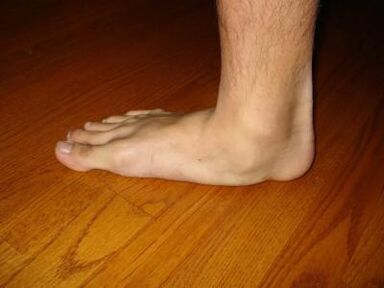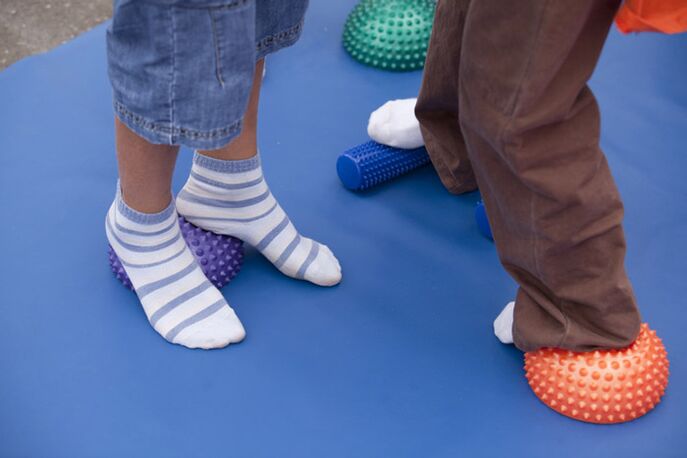Valgus deformation of the foot in children is a pathology in which the distance between the internal sides of the ankles is 4-5 cm or more during tight compression and the straightening of the legs.At the same time, the heel, along with the fingers, turns outside, and the inner feet arches seem to be flooded inward.

In orthopedics, this curvature of the legs is called X -shaped (with feet -wide deformation, on the contrary, a curvature in the form of O) is observed.If, at the bottom of Valgus deformation, a decrease in the height of the feet arches is observed, they say this is a flat valve deformation.
Typically, parents are visible to the deformation of Valgus from the foot to their child, when he performs seven to eight months for this period, the first independent attempts are.If you look at the flat deformation photo of the flat valves, the feet ", which may notice that the legs are folded in the knee joints, that" the feet "" look ", and the feet" and the feet ", the feet", the feet "and the feet", the feet "and the feet", the feet and the feet that fall.
Classification
In medicine, three degrees of gravity from the Valgus anomaly are distinguished:
- Light. The angle of height of the arc is less than 140 °, the height of the longitudinal arc of the stop is about 15 to 20 mm, the valve position of the back of the foot is about 10 °, the front section of the foot is attributed to 8 to 10 °, the jump bone is tilted by 15 °.
- Average.The height of the arc in the second degree of deformation of Valgus from the foot to children is 150 to 160 °, the height of the longitudinal safe is 10 mm, the heel bone is inclined by 10 °, the valg's position of the rear of the foot and the front vault is not exceeding 15 °.
- Heavy (steps).The height of the vault is 0 to 5 mm, the calcaneal tilt angle is 0 to 5 °, the angle of the arc vault exceeds 160-180 °, the position of the rear section and the lead of the front section is greater than 20 °.The child complains of constant pain in the joint.Severe severity of deformation is not subject to the correction.
There is another classification of the deformation of Valgus from the feet, which is based on the cause of the disease:

- Compensatory (caused by a reduced Achilles tendon).
- Structural (due to the innate irregular position of the RAM bone).
- Spastic (it is a consequence of muscle cramps that occur due to disturbances in the work of the cerebral cortex).
- Hyper correctional (caused by illiterate treatment of children's curvature).
- Rachitic (manifests in children with rickets).
- Paralytic (complication of encephalitis or polio).
- Traumatic (caused by an ankle joint bone fracture, ligament rupture).
Causes of deformation of feet valgs in children
Valgus deformation of the foot is congenital and acquired.In the first case, the causes of the disease are associated with intrauterine violation of bone location/shape.The diagnosis is made in childhood.
The acquired form of the Valgo Anomaly is not caused by the final tendons, as well as deviations in the development of the musculoskeletal system.Usually, the diagnosis of “stop deformation” is made by eight -month -old children or when a small patient is 1 year old.Deviation is more often formed in weakened children with muscle hypotension.
Among the most common causes of deformation of Valgus from foot to the child:
- Do not premature;
- intrauterine hypotrophy;
- Frequent diseases with bronchitis, acute respiratory viral infections, pneumonia;
- Congenital weakness of connective tissues;
- rickets;
- Ligament lesions, leg bones, muscles;
- Long stay in plaster;
- Obesity of children;
- Creating the child very early on the legs;
- Wearing incorrectly low quality/selected shoes.
In addition, Valgus's anomaly arises as a result:

- Cerebral palsy;
- Polyneuropathy;
- osteoporosis;
- dysplasia;
- endocrine and genetic disorders;
- Congenital laxation of the thigh;
- polio;
- Muscularis Destrophia.
Valgus deformation symptoms
Valgo deformation symptoms in children include:
- While walking, the child does not step all over, but only on the inner edge (the legs are "flooded" inside).
- The legs acquire a shape in the shape of X.
- The march becomes strange.
- The child complains about pain in the legs back.
- At night, a swelling of the feet, cramps is possible.
- The shoes the child wears are ripped unequal - first of all, the inner side of the sole is wearing out.
If you find similar symptoms in yourself, consult a doctor immediately.It is easier to prevent disease than dealing with the consequences.
Diagnosis
To make a diagnosis such as the deformation of Valgus from the stop, the traumatologist-orthocedist doctor examines the child and prescribes a special examination for him:
- Podometric (the method evaluates the distribution of load in certain departments of the feet);
- Computer Plantography (allows you to calculate the morphological parameters of the feet);
- Radiography (makes it possible to study changes in the feet position relative to each other).
In some cases an additional ultrasound of the joints is required.To exclude the connection of valgus deformation with central/peripheral nervous system diseases, the child is directed to the child neurologist.

As the deformation of Valgus from the feet in children is treated
The treatment of the deformation of Valgus of the feet in children aims to normalize the shape of the feet, restoring its functions, strengthening the ligament and muscle tracts.In case of congenital way of the disease, a children's orthopedist may prescribe the use of a plaster bandage.Conservative treatment also includes:
- Night baths.Improve muscle tone, ligaments.For the preparation of the bath, it is necessary to dissolve 1/3 cup of marine salt in 10 liters of warm water.Plant the child in the waist solution for 20 minutes.The sessions are held every day.One course includes 15 procedures.Repeat treatment every 4 months.
- Massage.Valgo deformation massage in children is one of the most important points of treatment.This must be done by a qualified expert.
- Mud and ozotoceros applications.
- Paraffin therapy.The paraffin wrap is done only on the foot or in the form of a boot.Heating improves blood circulation, ligaments.
- Acupuncture.
- Electrical stimulation of the muscles of the foot and the bottom of the leg.Promotes muscle strengthening.
- Electrophoresis, magnetotherapy.
- Exercise Therapy.LFK with Valgo de Foot deformation is performed daily.Properly selected exercises can improve ligament flexibility, muscle strength, increase joint mobility, normalize tissue metabolism, blood circulation.
To correct Valgus deformation of the feet, children should wear special shoes with hard side fixation of heels and feet, use individual functional insoles.As for sports, you can ride a bicycle with anomaly of Valgus, swim.
The disease uses surgical treatment in extreme cases (7%) if all conservative medical measures are ineffective.Could it be:

- Arthrodesis operations.Provide the immovable articulation between the heel bones and the talus, due to which the inner arch muscles intensify.
- Surgical intervention.The manual correction of the child's stop is performed after which the plaster is overlapping.The sessions are held once a week.After each of them, the foot changes position.The doctor applies plaster at full foot (from the middle third of the thigh).At the same time, the knee is bent at a ninety -degree angle.In the last session, the doctor repairs the anticular joint of Talus in the correct position, introducing Kirschner's knitting needle through the skin.Then he wears plaster for two months.
- Children who have undergone Valgus deformation of the feet with the help of surgery should always wear special orthopedic shoes that support the feet arches.
- Small invasive operations that change the angle between individual bones of the foot, because the ligament apparatus voltage increases.
Danger
If the degree of deformation is light, a complete recovery is possible.A serious degree of valgus deformation is not a common cosmetic defect.The disease causes serious limbs with functional deficiency, which can lead to disability.
The absence of competent anomaly treatment can cause:
- Smooth feet;
- constant pain in the legs;
- osteochondrosis;
- arthrosis;
- shortening of the limbs;
- Posture violation (scoliosis);
- Deformation of pelvis, ankle and knee joints.
Group of risk
The biggest risk of being sick with Valgus deformation occurs if parents put the child early (up to 9 months), buying low quality shoes or size is selected incorrectly.In addition, babies suffering from rickets, having a genetic predisposition to curvature, are also prone to pathology.
Prevention of Valgus de Pé deformation

Disease prevention includes the following points:
- You should not put the child standing for up to 9 months.
- Exclude the development of rickets (preventive intake of vitamin D).
- Buy shoes with orthopedic insoles.The backdrop of children's boots should be 3-4 cm higher than the heel.The sole should bend well.A prerequisite is the presence of a supervisor.
- Massage your feet.
Also, you should not ignore the programmed exams of an orthopedic neurologist.At 1 month of age, the doctor can diagnose the presence of congenital skeleton diseases in 3 and 6 months to exclude the development of rickets in 1 year to evaluate the volume of joint movements, the correction of vertebral curves at 3 years - check the staging, posture and measure the duration of the limbs.
It is impossible to recover quickly with the diagnosis of valgus deformation.Parents will be able to evaluate the first results not before six months after the beginning of conservative therapy.
This article is published exclusively for cognitive purposes and is not a scientific material or professional medical advice.























